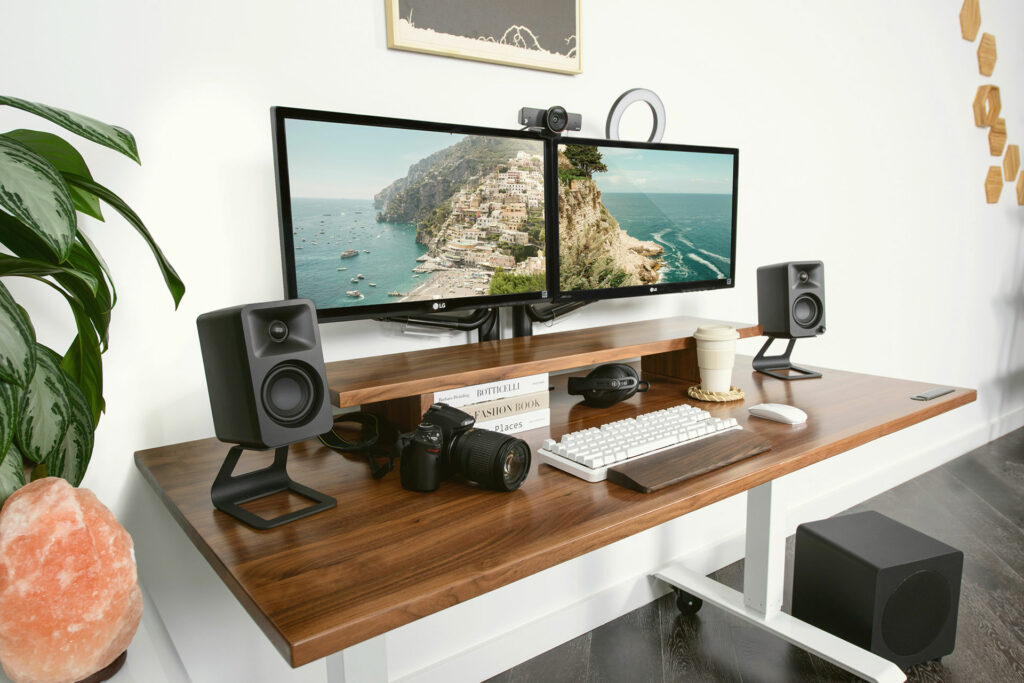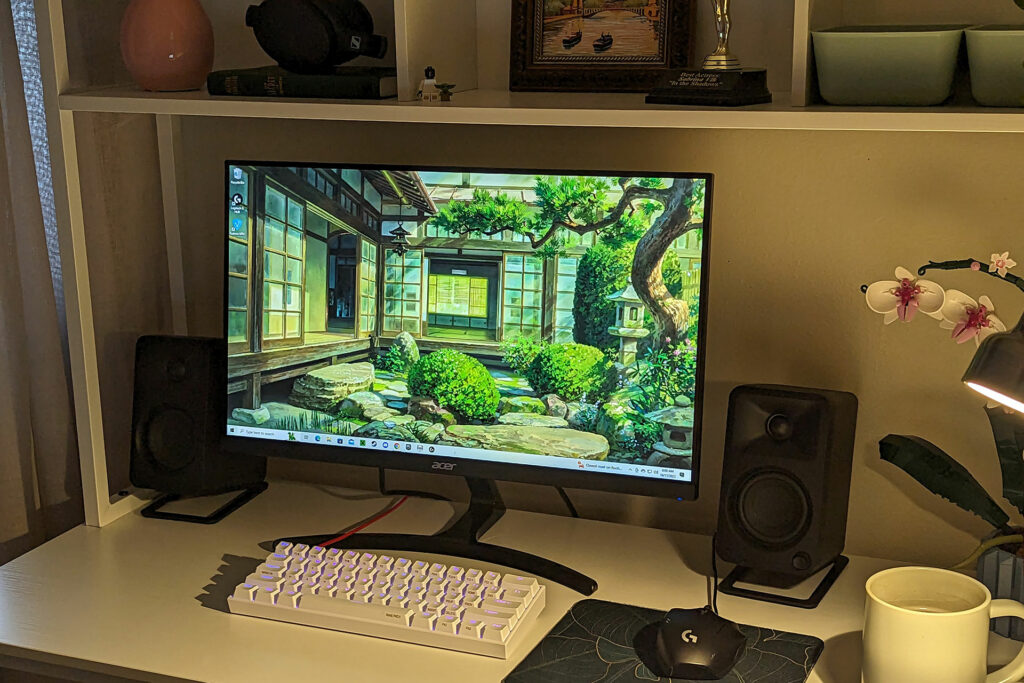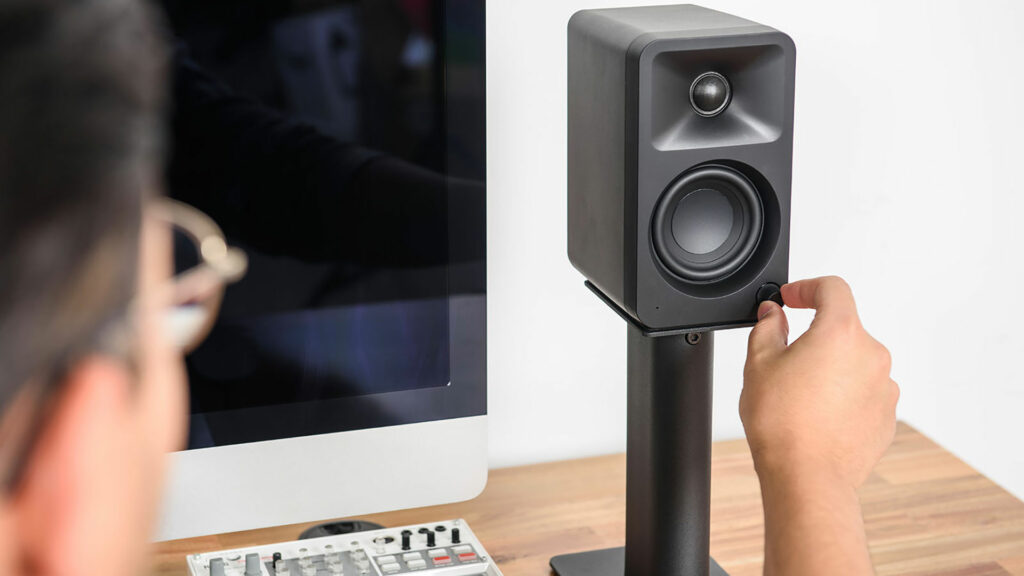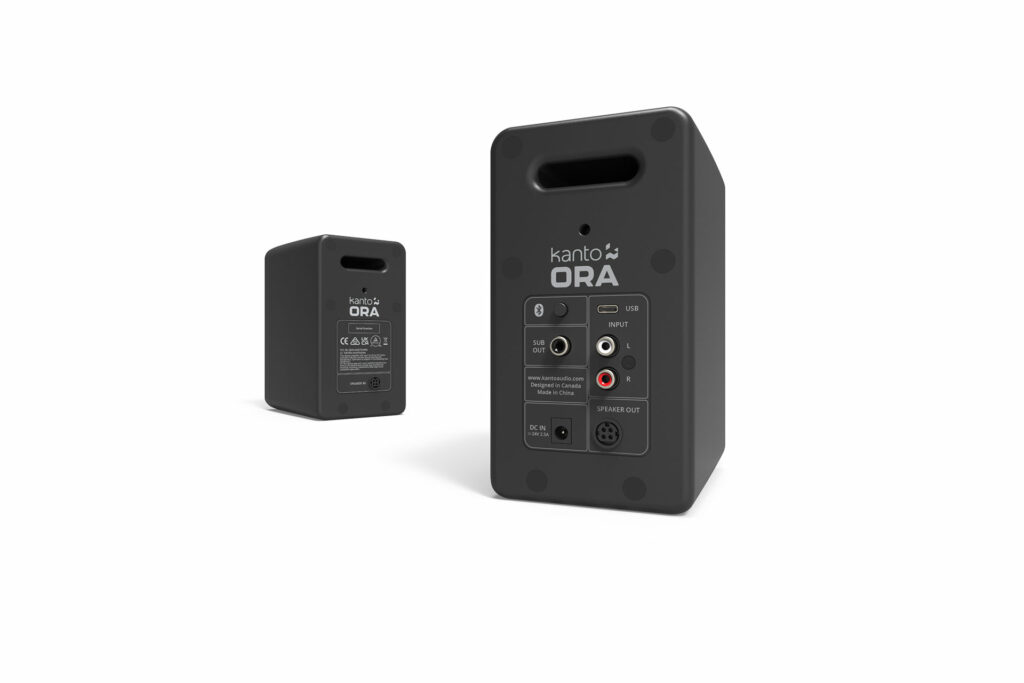The Kanto ORA Two-Way Active Wireless Reference Desktop Speakers by Kanto Living offer a refreshing blend of audiophile performance and versatility. Immediately, I was drawn to these speakers and their ability to produce clear and vibrant sound, which seems uniquely tailored for content creators, musicians, and gamers alike. While they boast an impressive range of technical specifications, what stood out to me was the ease with which they connected to various devices, especially their Bluetooth capabilities. These speakers look great, too; minimal design language along with their monotone colorway makes them appear modern and, dare I say, cool, in any desktop setup. They can fit in without drawing undue attention to themselves. The presence of rear mounting holes indicates that they’re versatile beyond just desktop applications, allowing for more tailored setup configurations. While I’ll dive deeper into the technicalities later on, the ORA speakers certainly make a strong first impression.

What Makes the Kanto ORA Desktop Speakers Special?
- The ORA caters to creators, gamers, and musicians alike. Designed to bridge the gap between ordinary computer speakers and studio monitors, they offer a sound quality that is both studio-grade and audiophile-approved.
- The Kanto ORA includes a plethora inputs, so you will have no problem integrating it with your desktop setup. With a range of digital inputs including USB-C for PCs and Macs, and Bluetooth 5.0 for smart devices, in addition to RCA for analog equipment, the Kanto ORA offers a seamless connection experience regardless of the device.
- The Kanto ORA boasts Reference Quality Sound for your desktop. With 50 Watts of DSP-tuned, bi-amplified Class-D power (100 Watts Peak), ORA ensures near studio-grade sound quality. The three-inch woofers provide surprisingly deep bass in a nearfield listening position, making the Kanto ORAs versatile enough for both studio and multimedia use.
- A built-in crossover is engaged automatically when a sub is connected, allowing the ORA to concentrate on mid and high frequencies. This seamless subwoofer integration means you get reduced distortion even at higher volumes as well as add some big bass despite the small size of the speakers.
- The speaker has a compact form factor that ensures it can comfortably fit on any desktop or even be carried in a backpack for on-the-go sessions.
- The analog RCA input ensures vintage tech lovers aren’t left out, making these completely retro-compatible.
- The ORA features a ¾-inch silk dome tweeter, three-inch magnetically shielded paper cone woofer, and a power output of 100 Watts peak power (50 Watts RMS). Its frequency response is reportedly 70 Hz to 22 kHz, ensuring a vast spectrum of sound capture and reproduction.

Why Should You Care About the Kanto ORA Desktop Speakers?
The Kanto ORA desktop speakers distinguishes itself from other desktop speakers with studio-grade sound quality from a reputable audiophile company. The modern inputs, like USB-C and Bluetooth 5.0, will ensure you will have no problem connecting them to any modern device. Its retro compatibility with older monitors is a standout feature. In short, the ORA speakers are a versatile and high-quality choice for close to any nearfield listening environment.
Listening to the Kanto ORA Desktop Speakers…
The Kanto ORA arrived as part of a package, complete with a complementary Kanto Sub 8 and a pair of Kanto S2 stands designed to angle the ORA speakers towards the listener. For a realistic demo, I set up the speakers in a nearfield desktop arrangement, emulating a typical user setup. The Sub 8 integrated seamlessly with the ORA speakers. For the digital-to-analog conversion, I employed my Topping e30 DAC-Preamp to bridge the connection between my PC and the Kanto speakers.
As Kanto has advertised the speakers to be used for a variety of media uses, the first thing I did was open up Steam and launch CD Projekt Red’s “Cyberpunk 2077”. The sprawling metropolis of Night City demands audio equipment that can capture its every nuance, from the distant hum of neon signs to the aggressive revving of futuristic motorbikes. The Kanto ORA speakers delivered with precision and depth. The ambient noises, character dialogues, and electronic beats of the game’s score were all crisp and well-defined. The action-packed sequences truly showcased the ORA’s capability, with gunshots ringing clear and explosions delivering a satisfying thud without overwhelming the overall mix.
To test out the speaker’s traditional hi-fi capabilities, I wanted to really push the Kanto ORA with some music that is both complex in soundstage and in frequency response, and my go-to for this is well-recorded and -mastered classical orchestra. After listening to “Merry-Go-Round of Life” composed by Joe Hisashi, and recorded by the Royal Philharmonic Orchestra, I was left extremely impressed by how well the ORA can image. During the performance, I could very accurately place where each set of instruments were in the ensemble, which came along with a depth that really opened up the soundstage. The details of the strings were sharp and very clear. With the subwoofer dialed in, the nearfield listening experience was comparable to sitting at my own full-scale reference system.
To round off my listening session, I ended with some acoustic rock. I cued up Kansas’s “Dust in the Wind” to great effect. The Kanto ORA’s delivery of this iconic track was deeply evocative. From the outset, the delicate guitar plucking was sharply defined, providing an immersive backdrop that felt genuinely present. When the vocals entered, I was taken aback by their clarity. Each lyric was presented with a crispness that made it easy to discern even the subtlest nuances in the singer’s voice. The raw emotion conveyed by the vocals, especially during the song’s poignant refrains, was emphasized remarkably, making the listening experience profoundly moving. The violin solo retained its haunting beauty, with every note echoing with precision. The ORA ensured that the balance between the track’s instrumental foundation and its powerful vocal moments was impeccably maintained. Overall, an extremely impressive performance for a pair of desktop speakers.
What You Might Not Like About the Kanto ORA Desktop Speakers
- Due to the nature of small form factor desktop speakers, the Kanto ORA suffers from limited low end without a subwoofer. While the ORA does an admirable job on its own, to truly unlock its full bass potential, you may need to invest in an external subwoofer. Although Kanto carries a matching subwoofer, known as the Sub8, this is an added expense for those seeking to get that full-range sound.

Who is the Competition for the Kanto ORA Desktop Speakers?
The Audioengine A5+ ($399 – Buy at Crutchfield) is renowned for its clear, detailed sound and strong bass despite its size. These powered speakers also feature Bluetooth, RCA, and mini-jack inputs. Unlike the Kanto ORA, they don’t have USB-C, but they are praised for their natural sound profile.
The Edifier R1280DB offers a blend of vintage and modern features, with Bluetooth and optical/coaxial inputs. Its classic wood finish complements both modern and traditional setups. What sets it apart from the ORA is the very low price point, offering a variety of essential features without breaking the bank.
The Presonus Eris E4.5 is marketed primarily as a studio monitor and delivers a flat frequency response ideal for mixing and mastering. It includes Bluetooth and has a larger 4.5-inch woofer. It might be an option for tighter budgets, or if you don’t have room for a matching subwoofer but still want lower bass response.

Do the Kanto ORA Desktop Speakers Have Any Resale Value?
Who knows, as Kanto speakers rarely ever show up used. Kanto is a well-known company in this mainstream audio product category, and well regarded in the budget audiophile world, so I do not see these speakers becoming worthless anytime soon. With that said, they are less than $400 retail, so they don’t cost much money and there isn’t much value to retain over time, as you likely will have safely consumed enough value from the speakers to toss them when you are done with them – not that you would ever do that, but you get my point.

Final Thoughts on the Kanto ORA Desktop Speakers
The Kanto ORA desktop speakers effortlessly integrate into any desktop environment and are very enjoyable across all media that I auditioned. Whether your setup is minimalist or brimming with gadgets, these speakers find their place without becoming obtrusive, marrying aesthetics with function seamlessly. Their compact form factor belies their auditory prowess, presenting a sonic experience that, given their price point, is nothing short of impressive. It’s a testament to their design that they can deliver such rich and nuanced sound without taking up too much space or breaking the bank.
During my testing phase, I spent some time opting to forego the additional subwoofer, and even then, the ORAs held their ground well. They delivered crisp highs and enough bass in the nearfield environment to get the point across. The ORAs ensured a balanced auditory experience that’s both immersive and clear. It’s evident that while adding a subwoofer can further enhance their performance, they’re robust and refined enough to stand alone, making them a versatile choice for various users.
Interestingly, it’s not just hardened audiophiles that find value in the Kanto ORA. My girlfriend, currently navigating the rigors of a college engineering undergrad, has found them to be an indispensable companion. Far from being an audiophile, she was initially drawn to their sleek design, which fit perfectly with her study setup environment. Even without the added subwoofer, they’ve found a permanent spot on her desk, regularly filling her room with the calming sounds of lo-fi beats during those endless study sessions. Their design appealed to her sense of aesthetics, and their performance made them an everyday essential for her music, and media consumption. That says a lot about their versatility and performance in my book.
To wrap things up, the Kanto ORA desktop speakers strike that delicate balance between form, function and affordability. They serve as a reminder that you don’t always have to compromise on quality for size or price. Whether you’re deeply into audio or just someone seeking a reliable sound solution for your workspace, the ORA promises and delivers.




Does the addition of DAC (Topping E30) bypass the internal DAC that only supports up to 16bits/48khz? Would be great if can get the speakers up to 24bit/96khz.